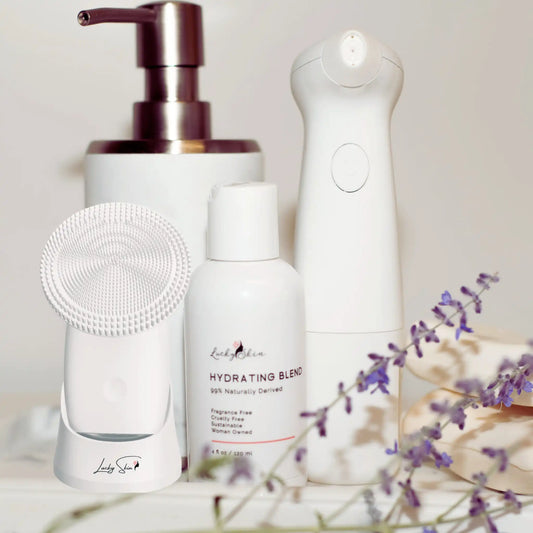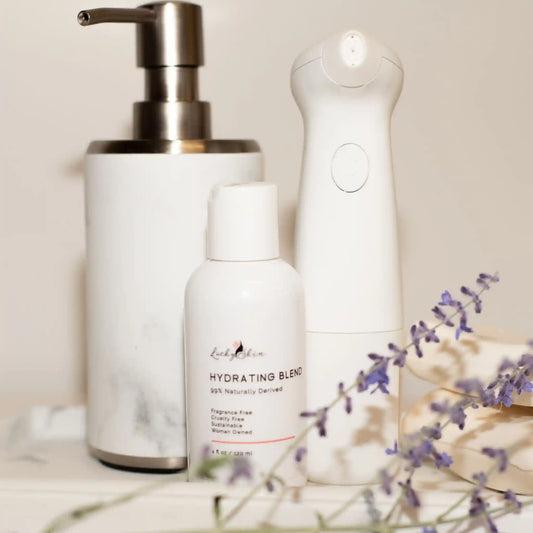What Skin Care Products Not To Mix
Share
When it comes to skincare, it's easy to get caught up in the latest trends and products promising miraculous results. However, not all skincare products play well together. When you use more than one skincare product at the same time, it's important to know what skin care products not to mix. In fact, mixing certain products can do more harm than good to your skin.
To help you navigate the world of skincare, here are some key products you should never mix:
Never Mix These Products
Retinol and Vitamin C
Both retinol and vitamin C are powerhouse ingredients when it comes to combating signs of aging and boosting skin radiance. However, using them together can lead to irritation and sensitivity. Retinol is known to be a potent ingredient that can cause dryness and peeling, while vitamin C can be acidic and may exacerbate these effects. It's best to use them on alternate days or at different times of the day to avoid any potential adverse reactions.
Benzoyl Peroxide and Retinol
Benzoyl peroxide is a common ingredient found in acne-fighting skin care products, while retinol is often used for anti-aging purposes. Mixing these two ingredients can lead to excessive dryness and irritation, as they both have drying effects on the skin. If you need to use both, it's best to use them at different times of the day or on alternate days to prevent over-drying your skin.
Alpha Hydroxy Acids (AHAs) and Beta Hydroxy Acids (BHAs)
AHAs, such as glycolic acid, and BHAs, such as salicylic acid, are exfoliating acids that help unclog pores and improve skin texture. While they can be beneficial when used separately, combining them can lead to excessive exfoliation and irritation. It's best to use them on alternate days or at different times of the day to prevent over-exfoliating your skin.
Niacinamide and Vitamin C
Niacinamide and vitamin C are both potent antioxidants that help brighten the skin and even out skin tone, however, mixing Niacinamide and Vitamin C can lead to the formation of niacin, which can cause skin flushing and irritation. It is recommended to space out their application to avoid potential interactions and maximize the benefits of each ingredient.
Vitamin C and Alpha Hydroxy Acids (AHAs)
Mixing Vitamin C and AHAs may seem tempting. But hold on! Mixing Vitamin C and Alpha Hydroxy Acids (AHAs) should be avoided due to their conflicting pH levels. Vitamin C requires a low pH to be effective, while AHAs work best at a higher pH. Combining them can lead to decreased efficacy of both, negating the intended benefits for your skin.
Oil-based and Water-based Products
Mixing oil-based and water-based products can lead to a lack of product effectiveness. Water and oil do not mix well, which can result in products separating or not blending properly. This can impact the overall performance and quality of the products, making them less effective. It's best to use products that are formulated to work together to ensure optimal results.
Tips for Properly Layering Skin Care Products
In the world of skincare, its crucial to know what skin care products not to mix however, applying products in the right order can make all the difference in achieving healthy, glowing skin. Properly layering your skincare products can enhance their effectiveness and ensure that your skin reaps the maximum benefits. If you've ever been confused about the order in which to apply your skincare products, fear not - we've got you covered with some expert tips for mastering the art of layering.
Why is Proper Layering Important?
Before we dive into the tips, let's first understand why proper layering is crucial for skincare. Layering your products in the correct order allows each product to penetrate the skin effectively and deliver its specific benefits. Additionally, applying products in the right sequence prevents them from cancelling each other out or reducing their efficacy.
Follow The Following 4-Tips
1. Start with the Thinnest Consistency:
As a general rule of thumb, apply skincare products with the thinnest consistency first. This includes products like toners, serums, and essences. These lightweight formulas can penetrate the skin more effectively when applied first.
2. Follow with Thicker Formulas:
After applying your lightweight products, move on to heavier formulas such as creams and lotions. These products help to seal in the benefits of the previous layers and provide hydration and nourishment to the skin.
3. Allow Each Product to Absorb:
Give each product some time to absorb into the skin before applying the next layer. This allows the active ingredients to work their magic without interference from other products.
4. Be Mindful of Active Ingredients:
It is crucial to be mindful of the compatibility of active ingredients when layering products. Some combinations may lead to irritation or diminish their effectiveness. Research thoroughly or seek professional advice to ensure the best results for your skincare routine.




